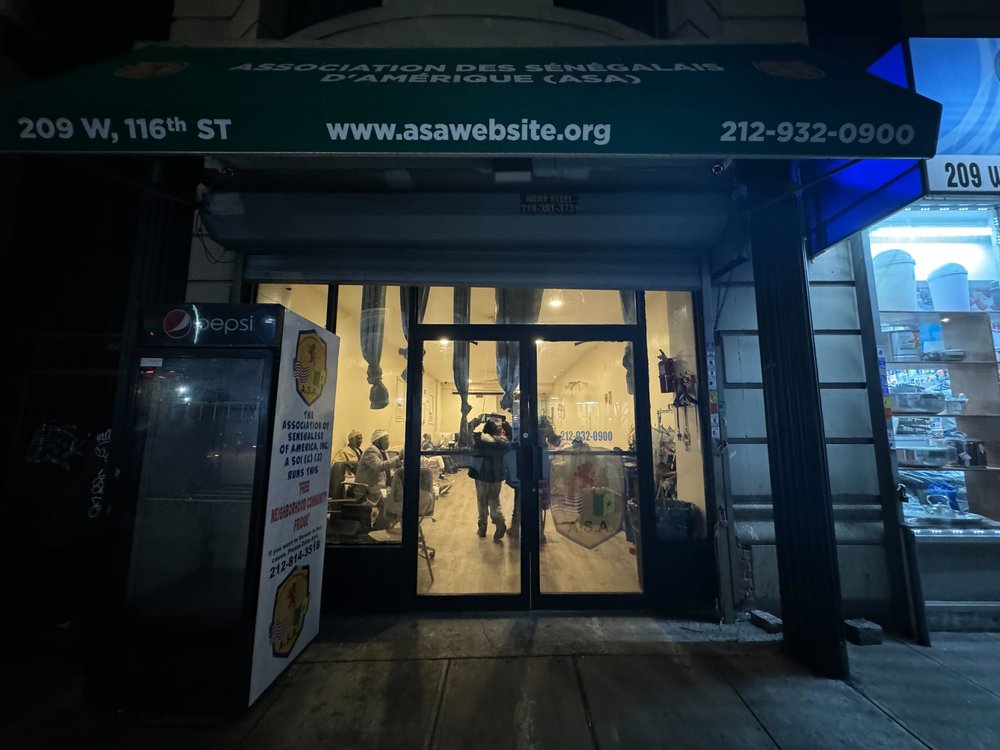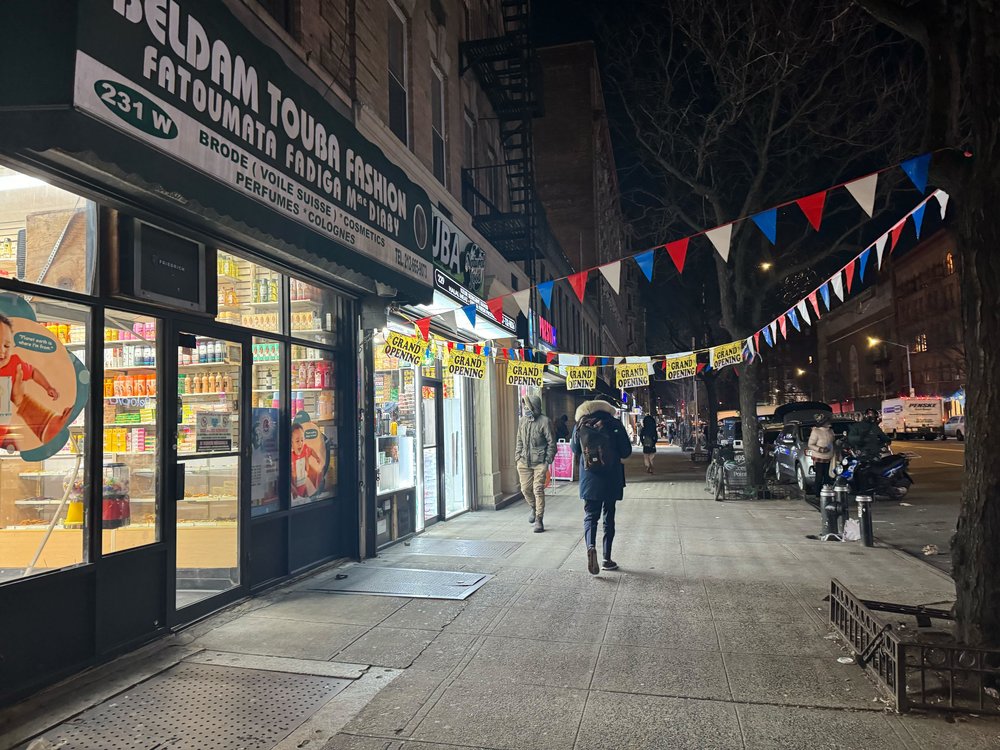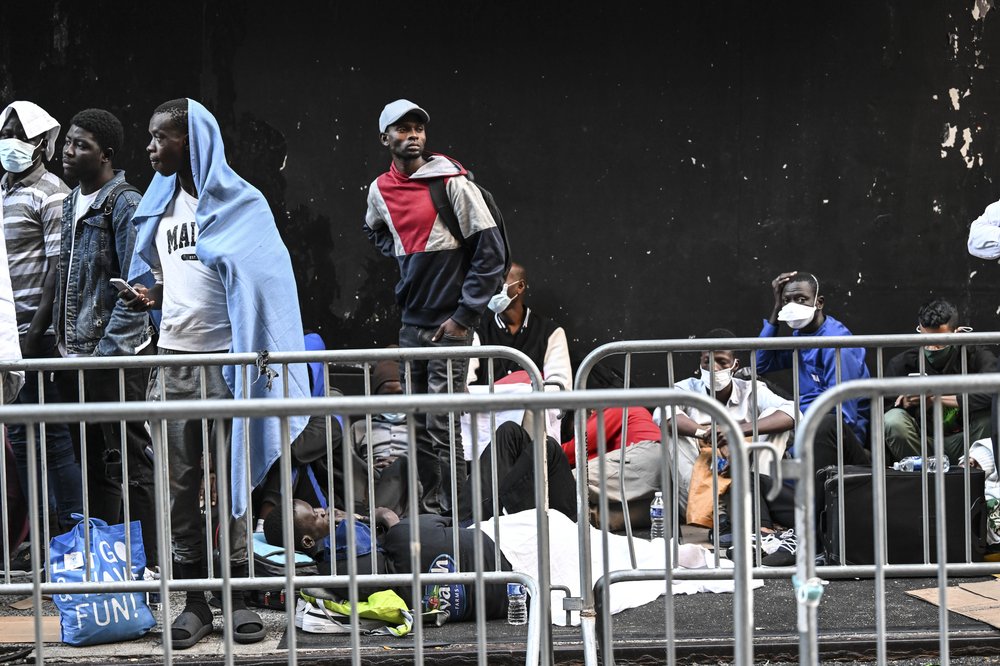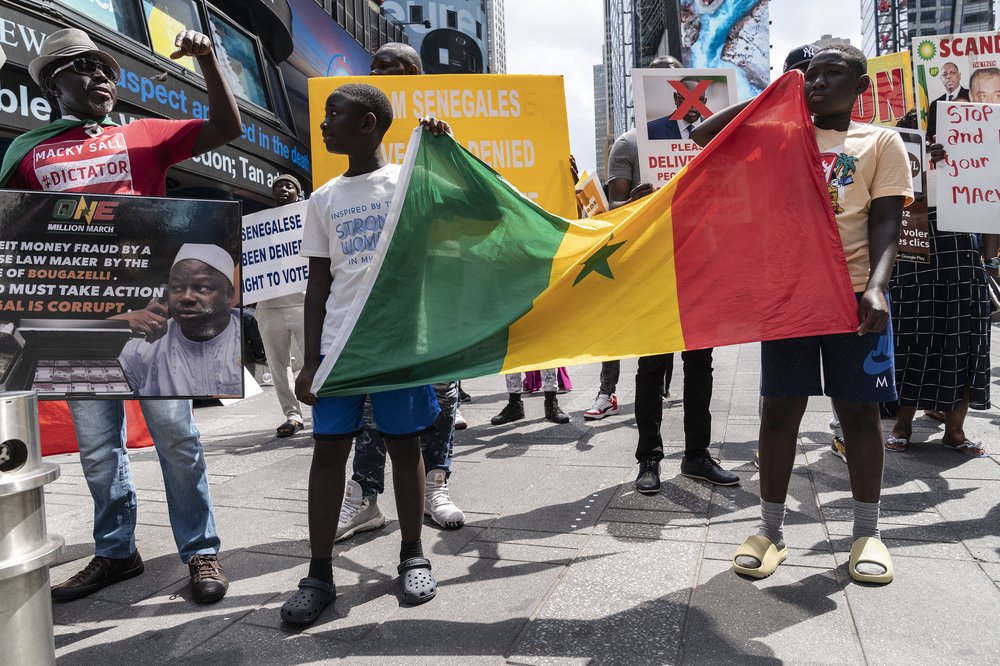In Harlem’s ‘Little Senegal,' West African migrants find community and challenges
Feb. 9, 2024, 11:01 a.m.
A network of expats has been quick to help, but has encountered neighborhood strain, language barriers and a shortage of needed support.

Harlem's "Little Senegal" has recently become an epicenter for a new wave of mostly young, male West African migrants, who are simultaneously finding community and challenges as well as coming to terms with the harsh realities of living in New York City.
The new arrivals, who are mostly in their late teens and 20s, are a conspicuous fixture on West 116th Street, where they often congregate. They speak in their native Wolof, which is commonplace in Senegal, and are typically seen toting insulated food-delivery backpacks on their e-bikes.
Some of them said they shelter in mosques and churches located nearby as well as in the Bronx and Westchester. They reassemble in the early morning, when a line forms outside the Senegalese Association of America's office, near St. Nicholas Avenue, where they go for help completing asylum applications.
“I always heard that 116th Street was ‘Little Senegal,’” said Ibrahim Mbengue, a 26-year-old Senegalese migrant, as he waited on a recent day. “That's why I came here.”
Although the city’s “migrant crisis” began nearly two years ago with an influx of Venezuelans and other Latin Americans who were bused north after crossing the southern border, the number of migrants from West African nations like Senegal, Guinea and Mauritania has tripled in the last year alone and garnered worldwide attention.

Although Harlem's West African community, which has deep roots in the neighborhood, has embraced the newcomers, there are signs of strain and ambivalence over the migrants according to community leaders, expats and the migrants themselves. And a city bureaucracy that critics say falls short of the newcomers' basic needs further amplifies the concerns.
Local nonprofits, including the Senegalese Association, have helped ease the migrants' transition, but some group leaders say they are being stretched to the limit.
“We want to help. We want to do all these services for free,” said the association’s President Mamadou Drame. “But hey, who's going to pay for the rent? Who's going to pay for the light to be on?”
Connection and conflict
So few African migrants were staying in city shelters at this time last year that they were grouped under an "other" category in City Hall data provided to Gothamist. But things changed. By Dec. 28, 6% of the 68,000 migrants in the city’s care were from Senegal, the fourth most common country of origin after Venezuela, Ecuador and Colombia. Guinea and Mauritania accounted for another 5% and 3% respectively.
This comes as the number of African migrants crossing the southern border has more than tripled over the last year, jumping from 13,406 in fiscal year 2022 to 58,462 in fiscal year 2023, according to data provided by the U.S. Customs and Border Protection.
Those numbers have helped change the landscape in Little Senegal.
We always heard when you come here, you’re going to find two jobs, you’re going to work, you’re going to survive. But when you come here, it’s hard to even find one job.
Ibrahim Mbengue, 26, from Senegal
“We always heard when you come here, you’re going to find two jobs, you’re going to work, you’re going to survive,” said Mbengue, the Senegalese newcomer. “But when you come here, it’s hard to even find one job.”
“It’s a fiction, what we heard,” he added.
At an electronics store off Malcolm X Boulevard on a recent Friday night, a line of young West African men waited to wire money back home. Others huddled inside to stay warm, and some traded e-bike batteries outside.
An older Senegalese immigrant opened the shop several months ago, and it has since become an informal gathering spot for new arrivals. Owner Papa Dioum, 37, offers them food and car rides, and sometimes helps connect them with lawyers.
Dioum said he feels an obligation to help after a Senegalese NYU student paid for his rent and groceries when he first arrived in the country and without a job.
“If I didn’t have that kind of help, it was going to be hard for me,” said Dioum, who has lived in the United States for 14 years. “And they’re facing the same situation. It’s the same thing I needed 14 years ago.”

Other shop owners and managers along 116th Street say they’ve given food, money, and jobs to needy new West African migrants who have come in seeking help, but not without cost.
Some local shop owners and longtime residents have complained about groups of newcomers obstructing the sidewalk, making noise and leaving trash.
Ahmed Conde, owner of the West African restaurant La Savane, recently installed a belt barrier outside his establishment because he said the new arrivals were congregating too close to his restaurant and customers were avoiding the entrance.
“The way things work in Africa and here is different,” said Conde, who added that he’s also hired three newcomers and given free food to many more. “Here is a law. You’ve got to respect people's space.”
Abdou Mbacke, a 23-year-old cashier at the Senegalese grocery store next door, said many new arrivals enter and sometimes try to haggle – as is customary back home — for nostalgic staples like peanuts, coffee and plastic containers of thiakry, a millet dessert.
Some buy large bags of cayenne and other seasonings to sell in individual packages to other migrants in shelters who want to spice up the bland food. Others buy thermoses and sell cups of coffee outside – just like the street vendors back home in Senegal.

“It's also a double-edged sword because the more people that come in, the less jobs,” said Mbacke, who grew up in the neighborhood, adding that the pool of delivery app workers is oversaturated and local drivers are making less money.
State Sen. Cordell Cleare, a Democrat whose district includes Harlem, has hosted clothing and food drives for the newcomers and organized a neighborhood task force on migrants.
She’s also reached out to local members of Congress to push for more African migrants to be eligible for a federal immigration program called Temporary Protected Status, which would authorize them to stay in the U.S. longer and speed up the process for them to obtain work permits. (City Hall has also called on the Biden administration to extend TPS to migrants from Cameroon, Mauritania, Nigeria and the Democratic Republic of the Congo, in addition to Venezuela, which was recently added.)
But Cleare has had to walk a fine line between helping the new arrivals while also honoring the quality-of-life concerns from long-standing residents in a neighborhood grappling with gentrification and historic disinvestment.
She organized a town hall meeting a few weeks ago to discuss concerns for longtime residents, business owners and community groups, and added that more meetings are forthcoming.
“There's a balance I’m trying to keep with folks to be understanding,” Cleare said. “There's already people feeling as if their needs are not being met.”
‘Unequal support’
Dramé, the president of the Senegalese American Association, said he discovered last year that West African migrants staying in a hotel shelter on 110th Street were going days without bathing. The reason: They couldn’t understand the staff’s once-daily calls for showers, which were made only in English and Spanish.
Other migrants living in the hotel ridiculed the West African men, saying they smelled and didn’t shower, Dramé said, adding that he felt the insults were racist. He and other African community leaders visited the hotel and relayed their concerns to management one day last fall.
“Africans are not getting equal help, equal support, like other communities,” said Mohamed O. Jalloh, one of the leaders present and the vice chair of the African Advisory Council to the Bronx borough president (though not speaking on behalf of the organization).
City Hall spokesperson Kayla Mamalek said the city has been in touch with African community organizations and has been funding immigrant rights workshops, legal help and social services at some local nonprofits.
She also said migrant shelters provide halal food, and some offer prayer spaces and rugs. She said the city has pushed to find more staff who can speak French and West African languages, and to make interpretation services available otherwise.
Africans are not getting equal help, equal support, like other communities.
Mohamed O. Jalloh, one of the leaders present and the vice chair of the African Advisory Council to the Bronx borough president
But local organizers and elected officials complain of an ongoing language barrier in shelters and in the delivery of city services that keeps African migrants from accessing potentially life-changing services. That includes access to pro bono lawyers to help migrants file asylum applications and secure identification cards that allow them to open bank accounts.
“Not knowing English is a big hardship,” said Imame Ka, 22, from Senegal, who asked not to share his full name publicly for fear of jeopardizing his immigration case. “The fact you don’t speak English is a big handicap because you cannot express your ideas, your thoughts the way you want. “
While some shelter staff members speak Spanish, far fewer speak French and other African languages. Security guards at shelters routinely communicate with migrants using translation apps like Google Translate.
Zaineb Hamid, director of the Bronx African women’s center Sauti-Yetu, said one caseworker at a family shelter reached out to her to ask for interpretation assistance for a group of West African women — but her organization wasn’t cleared to assist.
Several organizers also complain of migrants being turned away from social service agencies because staff can’t understand them, or waiting for hours to access a telephonic interpreter contracted by the city.
“We’re way behind in building out infrastructure to serve them, relative to Spanish-speaking migrants,” Manhattan Borough President Mark Levine said.
‘Our numbers are off the chart’
The ongoing wave of migrants – some 170,000 have come since spring 2022 – was long an abstraction for many New Yorkers. That changed in August, when viral images circulated of migrants in Midtown sprawled out on the pavement outside the Roosevelt Hotel waiting for shelter beds. Many of them were West African men.
City Hall, which initially claimed to be out of shelter space, quickly scrambled to find beds for the migrants. But the jarring footage was seen throughout the world, and was perhaps the first concrete sign that New York City was struggling to do what it had seemingly always done: accept new arrivals.

Some of the West African migrants in Harlem told Gothamist they had fled political persecution and turmoil. Others said they sought better economic opportunities. More are also coming to the United States because of tighter border restrictions in Europe and more publicized routes through the Americas, according to immigration experts.
“All these things are publicized through social media where no government entity can compete,” said Muzaffar A. Chishti, a senior fellow at the Migration Policy Institute and the director of its office at NYU's School of Law. “They act like travel agencies now.”
Yet the city was a popular destination for Black immigrants long before the current wave. New York City's 1.1 million Black immigrants made up the largest such population in the country in 2019, according to a Pew Center analysis of Census data. The city was also home to the largest number of African migrants, at 200,000 from 2015 to 2019, according to an analysis by the Migration Policy Institute.
But the new newcomers have nonprofits that serve African migrants feeling the strain.
The Harlem-based African Services Committee, founded in 1981 by an Ethiopian refugee, now sees 30 to 40 walk-ins per day, up from just five to eight around the same time last year. The Senegalese Association now sees over 40 people a day, compared to about three before last year.
“Our numbers are off the charts,” said Amanda Lugg, executive director of the African Services Committee. “We have not seen numbers like this ever.”

Dramé says the Senegalese Association of America burned through $200,000 hiring several paid assistants after previously only needing one. The nonprofit's services have almost entirely pivoted to helping new arrivals translate legal documents and file asylum applications.
And for some African immigrants on the front lines, the struggles of new arrivals can especially hit home. Adama Bah, for example, came to the United States as an undocumented immigrant from Guinea and founded the nonprofit Afrikana, a community center for migrants in Harlem.
“It really hurts my heart that I have to even say this,” said Bah, who's also seen a large share of African women migrants. “Because it's people that look like me, they're having such a hard time.”
On one fall morning at the office of the Harlem-based group African Communities Together, staff member Sophie Kouyate offered tea and bread to two young Mauritanian men seated at a table in a backroom. They were seeking to relocate after encountering difficulties in their tent shelter.
One of the men, just 22 years old, told her that it had been months since he had eaten food around a table, as he had with family in Mauritania. Kouyate, who is a French immigrant with African heritage, began to sob, as the two men remained stone-faced, and told her it would be OK.
Using Google Translate, the men told Kouyate in Arabic that they felt “the tenderness of our mothers.” When asked why they remained so stoic, they said it was because of the difficulty of the trek, which included assaults and beatings along the road.
“We no longer feel,” they said.
NYC’s first African worker-owned language cooperative is open for business New Yorkers back ‘right to shelter,’ but hold ambivalent views on housing migrants The African American exodus from New York City For NYC migrants, just getting inside immigration courthouse is a feat